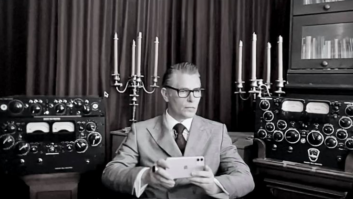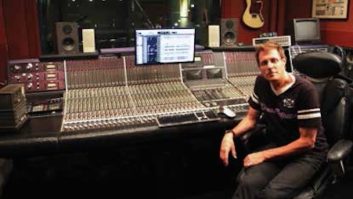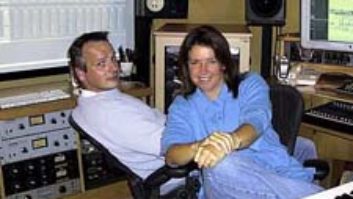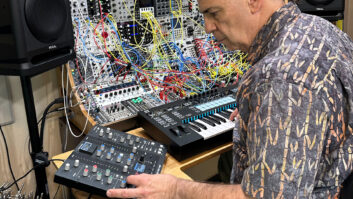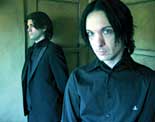

Tweakers Clint Green (background) and Chris Vrenna—awake enough to pose for the camera
Sleep deprivation sounds like it would be an artistic inhibitor, yet Chris Vrenna found it to be a powerful inspiration when assembling Tweaker’s new album, 2 a.m. wakeup call. After his wife repeatedly found herself waking up at 2 a.m. night after night, and waking him to prove it was no fluke, he began to explore the concepts of dreams, nightmares and insomnia. With its striking mixture of moods, musical styles and guest vocalists, the latest Tweaker album — which runs the gamut from heavy rock sounds to spacey ambient interludes — appropriately reflects a turbulent night of semi-sleeplessness.
Such aural adventures are natural for Vrenna, the former Nine Inch Nails drummer who composed the soundtrack to the video game Alice and has remixed such diverse artists as Weezer, P.O.D. and David Bowie, among many other endeavors. Since recording Tweaker’s 2001 debut, the attraction to all things uncertain, Vrenna has also teamed up with guitarist Clint Walsh, who plays with The Motels and actress Juliette Lewis’ band. The two make a good fit.
“Clint and I did the bulk of the work on the record, especially the writing and a lot of the sound creation, very late at night, just because daytime gets so crazy and hectic working on scores or remixes,” explains Vrenna. Besides, he jokes, his wife would have poked him awake anyway. The nocturnal sessions recalled his Nine Inch Nails days when his former band recorded all night.
Like Tweaker’s debut, 2 a.m. wakeup call traverses a wide range of musical ground, although Vrenna feels that the new album is more cohesive. “It’s not an electronic record, but it definitely is electronic-sounding somehow,” he notes. “Even though we’re using more organic instruments, you certainly couldn’t call it a plain-old organic rock record.” Unlike the first Tweaker album, which was developed more from sonic experimentation, Vrenna and Walsh began writing with simple instrumentation and then expanded their palette of sounds once the tunes were fleshed out.
Contrasts between (and often within) songs define 2 a.m. wakeup call. The opening track, “Ruby,” alternates between delicate acoustic passages and a “Melvins-heavy” rock groove. A bubbling, gurgling, NIN-like synth line and electronic drum sound drive the brooding “Truth Is.” The ominous “Movement of Fear,” a cover of the Tones on Tail tune with the saxophone part played on trumpet by Walsh, has a distinctly Spaghetti Western feel to it. And the dreamy closing number, “Crude Sunlight,” with its mixture of plucked guitar parts and e-bow harmonies, acts as a lullaby to lull the listener to sleep. “We effected everything in it to sound [like] AM radio or Victrola,” reveals Vrenna. “We went sound by sound and effected [each one] separately and then put them together.”
2 a.m. wakeup call begins with a more energetic, upbeat mood, but as the story progresses and the further “through the night” the listener goes, things get darker and heavier until the soporific finale. The concept is relayed through a variety of vocalists, including Robert Smith (The Cure), David Sylvian, Jennifer Charles (Elysian Fields), Nick Young (A.I.), Hamilton Leithauser (The Walkmen), Mellowdrone and Will Oldham (Palace Brothers).
Vrenna admits that working with vocals recorded under different conditions and of varying quality was challenging with one exception: Each singer used his or her own home studio for vocals. “This record was done through Pro Tools and FedEx,” quips Vrenna. “Once the singer agreed to be on the project and they heard the music and picked the song that they would want to be on, we talked concept and the whole approach. They wrote their own lyrics, given the concept of my album, because all of the Tweaker albums are concept albums. With every song having a different vocalist, it helps tie the record together.”
Some singers sent back initial ideas in MP3 form, but others did not. “Once they recorded, I would get a finished Pro Tools session back in the mail,” says Vrenna. “I just imported the whole track back into my session, which I had usually worked on while they were doing their vocals.” The same went for former Smiths guitarist Johnny Marr, who played on “The House I Grew Up In.” While on tour supporting Björk, Oldham had time to visit Vrenna in L.A., so they recorded his vocals with a Soundelux 47 FET mic, Vintech X73 preamp/EQ and a Universal Audio 1176 compressor.

Chris Vrenna surrounded by enough gear to tweak an album to his heart’s content
Vrenna’s home studio takes up two bedrooms with the larger bedroom as the control room. His house was built in the 1930s, so the smaller crib room adjoining the control room has a separate door. “The crib room is pretty small, about 10 by 12,” he says. “That’s my little over-dub room where we do vocals and combo amps, things of that nature.”
When it comes to gear, Vrenna is all about analog and analog/digital hybrids. He loves his Korg microKORG with its superior Vocoder. Software synth-wise, he uses “all the Native Instruments stuff. I really like Battery. The B4 is on the Tweaker record in a few different places. Since I’m committed to Pro Tools, I can’t be bothered hooking up second computers and PCs. To me, that isn’t going to make my song any better. I do like all the Eric Persing [of Spectrasonics] stuff: Stylus, Trilogy and Atmosphere in particular. I have a Virus plug-in and just got Mach 5 recently. I know it’s Version 1.0, but it works well and is pretty efficient. There hasn’t been a software sampler yet for Pro Tools.”
In terms of keyboards, Vrenna notes, “I just like big, shiny keyboards with lots of lights. My sampler is still an E-mu: the E4 Ultra. I still use it every day of my life. They discontinued them because they’ve gone software, as well with the new E-mu X Series, so I’ve been picking up used E-mu’s out of the Recycler and eBay and building a couple more hardware samplers just so I have them.” His arsenal also includes a Waldorf Microwave XT, Kurzweil K2000/R, Roland V Synths, an old Virus updated “as far as it will go,” a Nord Lead 2, Alesis Andromeda A6 and “a good old trusty JP8000.”
Vrenna says that most of the bass and guitar parts on the album were recorded direct. “Every single bass sound — and everyone’s going to shoot me for saying this — is a [Line 6] Bass Pod Pro,” he says. “But then I come out of the Bass Pod Pro and always put that through my Summit Audio TD-100 tube DI. I don’t use the compression within the Pod. I put that through an API and then my ADL tube compressor. Then that goes in. I use [the Pod] for its tones and then do other stuff.” As for the guitars, “A lot of the heavy guitar stuff is the Mesa Tri-Axis and the Recto Directo, things like that. Most of it is direct.” When he did choose to mike the amp, he used either a Shure 57 or a Sennheiser 421.
Because he is a drummer capable of writing his own beats, Vrenna never uses loops. For programmed sounds, he often uses Battery and employs the drum sounds his synths have. “I tend to just start from some of those and layer stuff,” he remarks. “I just layer sounds underneath and then make my own stuff, and then put those through pedals.” With limited space in the crib room, Vrenna uses a compact Yamaha custom drum kit. Vrenna pads the room down when he records vocals, but then he pulls the padding off the walls for a boomier drum sound. Longtime friend and engineer Bill Kennedy, whom the drummer has known since his NIN days, helped him experiment with different ways to mike the kit and they created a good overall scheme.
To record the kit, Vrenna placed a vintage AKG D-12 inside the kick and a Yamaha NS-10 (used as a mic rather than a speaker) outside the kick. “It gives you a nice sub,” he says. “You put that in front of the kick head.” For the snare, he placed a Shure SM7 on top and a Sennheiser 441 below. Sennheiser 421s are used on the two toms and either an AKG 451 or a Shure SM7 on the hi-hats. He favors the 451 because while the SM7 “gives a nice, thick chunky hi-hat, being such a small room, I kind of needed to thin it out.”
With restricted space for overheads, he utilized a RODE stereo mic. “It sounds awesome,” remarks Vrenna. “Now I have just one stand and I can center it. I don’t have to worry about two huge booms.” But he did experiment by taping a pair of Crown PZMs to the walls. “My studio has a little hallway outside of the room that can be sealed off from all the other rooms in the house, and then there’s a bathroom in that hallway that you can close. There’s a skylight in that little hallway. We’d sometimes stick an [AKG] 414 around the corner, in the bathroom, put it on the floor or sometimes we’d stick it way up in the skylight — just weird combinations like that.”
Though Vrenna does most of his recording work in Pro Tools, he still likes his “trusty [Yamaha] 02RV2. It’s seven years old. I have it loaded with four AES cards, which gives me 32 [channels]. Then I have one extra 888/24 set up as a hardware insert box, where I just have XLR snakes. I can use all my external stuff while I’m mixing.”
His recording chain includes a mixture of vintage and contemporary analog gear: an API Lunchbox with EQs, a pair of API mic preamps, a Vintech X73 preamp, a full rack of GMLs, a pair of Avalon U5 DIs and a pair of Summit tube TD-100s. For outboard compression, he owns an 1176, a Distressor, a pair of old dbx 160s, an ADL 1000, an old Vocal Stressor from Audio Design Recordings, a pair of 160Xs and a Joe Meek. “I take any combination there, depending upon what I’m tracking,” he says. “It gets me into Pro Tools, and then I have an Apogee as well that I use as my main head.”
Still, Vrenna stresses, “It’s not all of the new options that make creativity. I think it’s actually removing options that make creativity. When you’re making this weird record and you don’t have a budget to go anywhere and you have to do it all at home — all right, there’s my limitation. Let’s see what we can do. And it makes it fun, too.”

• Got the “morning jitters?” So does Chris Vrenna. Read about
it here.
• Hear song clips from 2 a.m. wakeup call:
